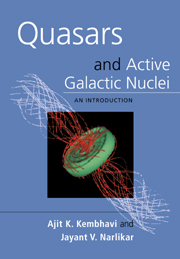Book contents
- Frontmatter
- Contents
- Preface
- Acknowledgments
- Acronyms and abbreviations
- 1 HISTORICAL BACKGROUND
- 2 THE COSMOLOGICAL FRAMEWORK
- 3 RADIATIVE PROCESSES–I
- 4 RADIATIVE PROCESSES–II
- 5 THE STANDARD MODEL
- 6 SURVEYS
- 7 LUMINOSITY FUNCTIONS
- 8 THE CONTINUUM
- 9 RADIO PROPERTIES
- 10 X-RAY EMISSION
- 11 X-RAY AND GAMMA-RAY SPECTRA
- 12 UNIFICATION
- 13 QUASAR ABSORPTION LINES
- 14 GRAVITATIONAL LENSING
- 15 PROBLEMS AND CONTROVERSIES
- References
- Books, reviews and proceedings
- Author index
- Subject index
9 - RADIO PROPERTIES
Published online by Cambridge University Press: 05 June 2012
- Frontmatter
- Contents
- Preface
- Acknowledgments
- Acronyms and abbreviations
- 1 HISTORICAL BACKGROUND
- 2 THE COSMOLOGICAL FRAMEWORK
- 3 RADIATIVE PROCESSES–I
- 4 RADIATIVE PROCESSES–II
- 5 THE STANDARD MODEL
- 6 SURVEYS
- 7 LUMINOSITY FUNCTIONS
- 8 THE CONTINUUM
- 9 RADIO PROPERTIES
- 10 X-RAY EMISSION
- 11 X-RAY AND GAMMA-RAY SPECTRA
- 12 UNIFICATION
- 13 QUASAR ABSORPTION LINES
- 14 GRAVITATIONAL LENSING
- 15 PROBLEMS AND CONTROVERSIES
- References
- Books, reviews and proceedings
- Author index
- Subject index
Summary
Introduction
About 10 per cent of giant elliptical galaxies and quasars are radio loud, which means that they have a radio luminosity of ≈ 1041–1046 erg sec-1 in a band extending from ≈ 102 MHz to ≈ 10 GHz. This corresponds to a 5 GHz luminosity ≿ 1025 W Hz-1 and, for the observed range of redshift, a 5 GHz flux ≿ 102 mJy. The ratio of the radio luminosity to the optical luminosity in these objects is ≿ 10. The criteria for separating radio-loud objects from radio-quiet objects are to some extent subjective; they identify a somewhat vague boundary on the brighter side of which rather spectacular manifestations of radio emission from active galaxies become evident.
Radio objects that do not belong to the radio-loud class are not radio quiet. Our Galaxy has a radio luminosity of ≈ 1037 erg sec-1, while Seyfert galaxies show a whole range of radio luminosity up to the boundary of the radio-loud class. The non-thermal emission in normal galaxies can be traced to their centres, supernovae, active stars, energetic particles in the magnetic field of the interstellar medium (ISM) and so on. In the more luminous Seyfert galaxies, the radio emission originates in the supernovae in starburst regions, though in the most luminous cases it is possible that mechanisms similar to those in radio-loud galaxies are in operation.
The radio properties of radio-loud quasars, which are in the minority in the whole quasar population, are quite distinct from those of radio-quiet quasars.
- Type
- Chapter
- Information
- Quasars and Active Galactic NucleiAn Introduction, pp. 214 - 272Publisher: Cambridge University PressPrint publication year: 1999



